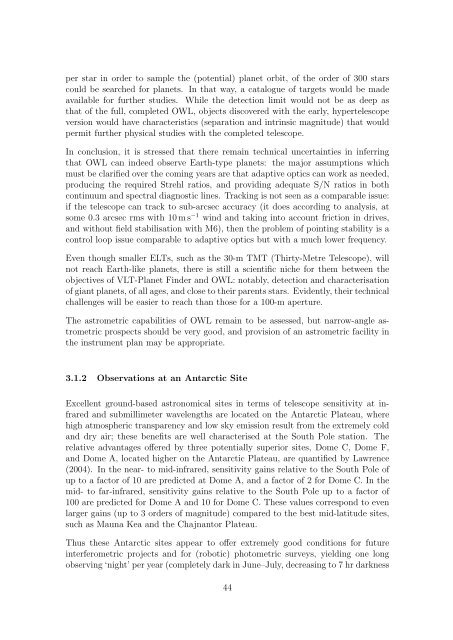Report - School of Physics
Report - School of Physics
Report - School of Physics
Create successful ePaper yourself
Turn your PDF publications into a flip-book with our unique Google optimized e-Paper software.
per star in order to sample the (potential) planet orbit, <strong>of</strong> the order <strong>of</strong> 300 stars<br />
could be searched for planets. In that way, a catalogue <strong>of</strong> targets would be made<br />
available for further studies. While the detection limit would not be as deep as<br />
that <strong>of</strong> the full, completed OWL, objects discovered with the early, hypertelescope<br />
version would have characteristics (separation and intrinsic magnitude) that would<br />
permit further physical studies with the completed telescope.<br />
In conclusion, it is stressed that there remain technical uncertainties in inferring<br />
that OWL can indeed observe Earth-type planets: the major assumptions which<br />
must be clarified over the coming years are that adaptive optics can work as needed,<br />
producing the required Strehl ratios, and providing adequate S/N ratios in both<br />
continuum and spectral diagnostic lines. Tracking is not seen as a comparable issue:<br />
if the telescope can track to sub-arcsec accuracy (it does according to analysis, at<br />
some 0.3 arcsec rms with 10 m s −1 wind and taking into account friction in drives,<br />
and without field stabilisation with M6), then the problem <strong>of</strong> pointing stability is a<br />
control loop issue comparable to adaptive optics but with a much lower frequency.<br />
Even though smaller ELTs, such as the 30-m TMT (Thirty-Metre Telescope), will<br />
not reach Earth-like planets, there is still a scientific niche for them between the<br />
objectives <strong>of</strong> VLT-Planet Finder and OWL: notably, detection and characterisation<br />
<strong>of</strong> giant planets, <strong>of</strong> all ages, and close to their parents stars. Evidently, their technical<br />
challenges will be easier to reach than those for a 100-m aperture.<br />
The astrometric capabilities <strong>of</strong> OWL remain to be assessed, but narrow-angle astrometric<br />
prospects should be very good, and provision <strong>of</strong> an astrometric facility in<br />
the instrument plan may be appropriate.<br />
3.1.2 Observations at an Antarctic Site<br />
Excellent ground-based astronomical sites in terms <strong>of</strong> telescope sensitivity at infrared<br />
and submillimeter wavelengths are located on the Antarctic Plateau, where<br />
high atmospheric transparency and low sky emission result from the extremely cold<br />
and dry air; these benefits are well characterised at the South Pole station. The<br />
relative advantages <strong>of</strong>fered by three potentially superior sites, Dome C, Dome F,<br />
and Dome A, located higher on the Antarctic Plateau, are quantified by Lawrence<br />
(2004). In the near- to mid-infrared, sensitivity gains relative to the South Pole <strong>of</strong><br />
up to a factor <strong>of</strong> 10 are predicted at Dome A, and a factor <strong>of</strong> 2 for Dome C. In the<br />
mid- to far-infrared, sensitivity gains relative to the South Pole up to a factor <strong>of</strong><br />
100 are predicted for Dome A and 10 for Dome C. These values correspond to even<br />
larger gains (up to 3 orders <strong>of</strong> magnitude) compared to the best mid-latitude sites,<br />
such as Mauna Kea and the Chajnantor Plateau.<br />
Thus these Antarctic sites appear to <strong>of</strong>fer extremely good conditions for future<br />
interferometric projects and for (robotic) photometric surveys, yielding one long<br />
observing ‘night’ per year (completely dark in June–July, decreasing to 7 hr darkness<br />
44
















